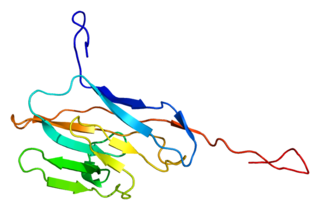Nongonococcal urethritis (NGU) is an inflammation of the urethra that is not caused by gonorrheal infection.
Mycoplasma hominis is a species of bacteria in the genus Mycoplasma. M. hominis has the ability to penetrate the interior of human cells. Along with ureaplasmas, mycoplasmas are the smallest free-living organisms known.
Ureaplasma urealyticum is a bacterium belonging to the genus Ureaplasma and the family Mycoplasmataceae in the order Mycoplasmatales. This family consists of the genera Mycoplasma and Ureaplasma. Its type strain is T960.

Excitatory amino-acid transporter 4 (EAAT4) is a protein that in humans is encoded by the SLC1A6 gene.

In biology and especially genetics, a mutant is an organism or a new genetic character arising or resulting from an instance of mutation, which is generally an alteration of the DNA sequence of the genome or chromosome of an organism. The term mutant is also applied to a virus with an alteration in its nucleotide sequence whose genome is RNA, rather than DNA. In multicellular eukaryotes, a DNA sequence may be altered in an individual somatic cell that then gives rise to a mutant somatic cell lineage as happens in cancer progression. Also in eukaryotes, alteration of a mitochondrial or plastid DNA sequence may give rise to a mutant lineage that is inherited separately from mutant genotypes in the nuclear genome. The natural occurrence of genetic mutations is integral to the process of evolution. The study of mutants is an integral part of biology; by understanding the effect that a mutation in a gene has, it is possible to establish the normal function of that gene.

Putative G-protein coupled receptor 42 is a protein that in humans is encoded by the GPR42P gene.

Carcinoembryonic antigen-related cell adhesion molecule 1 (CEACAM1) also known as CD66a, is a human glycoprotein, and a member of the carcinoembryonic antigen (CEA) gene family.

Carcinoembryonic antigen-related cell adhesion molecule 8 (CEACAM8) also known as CD66b, is a member of the carcinoembryonic antigen (CEA) gene family. Its main function is cell adhesion, cell migration, and pathogen binding.

Olfactory receptor 10H1 is a protein that in humans is encoded by the OR10H1 gene.

Olfactory receptor 7A10 is a protein that in humans is encoded by the OR7A10 gene.

Transcription factor HES-5 is a protein that in humans is encoded by the HES5 gene.

Protein sprouty homolog 4 is a protein that in humans is encoded by the SPRY4 gene.
Ureaplasma parvum is a species of Ureaplasma, a genus of bacteria belonging to the family Mycoplasmataceae.
Ureaplasma canigenitalium is a species of Ureaplasma, a genus of bacteria belonging to the family Mycoplasmataceae. It has been isolated from dogs. It possesses the sequence accession no. for the type strain: D78648.
Ureaplasma felinum is a species of Ureaplasma, a genus of bacteria belonging to the family Mycoplasmataceae. It has been isolated from cats. It possesses the sequence accession no. for the type strain: D78651.
Ureaplasma gallorale is a species of Ureaplasma, a genus of bacteria belonging to the family Mycoplasmataceae. It has been isolated from chickens and barnyardyard fowl. It possesses the sequence accession no. for the type strain: U62937.
Ureaplasma diversum is a species of Ureaplasma, a genus of bacteria belonging to the family Mycoplasmataceae. It possesses the sequence accession no. for the type strain: D78650.
The exact role of Mycoplasma hominis in regards to a number of conditions related to pregnant women and their (unborn) offspring is controversial. This is mainly because many healthy adults have genitourinary colonization with Mycoplasma, published studies on pathogenicity have important design limitations and the organisms are very difficult to detect. The likelihood of colonization with M. hominis appears directly linked to the number of lifetime sexual partners Neonatal colonization does occur, but only through normal vaginal delivery. Caesarean section appears protective against colonization and is much less common. Neonatal colonization is transient.
Ureaplasma urealyticum is a species in the genus Ureaplasma that can cause infection. Though most bacteria possess a cell wall, U urealyticum does not. It is found in about 70% of sexually active humans. It can be found in cultures in cases of pelvic inflammatory disease and is transmitted through sexual activity or from mother to infant during birth. It is not a commensal of the healthy uterine or amniotic microbiome. Infection with U. realyticum can contribute neonatal infection and negative birth outcomes.






